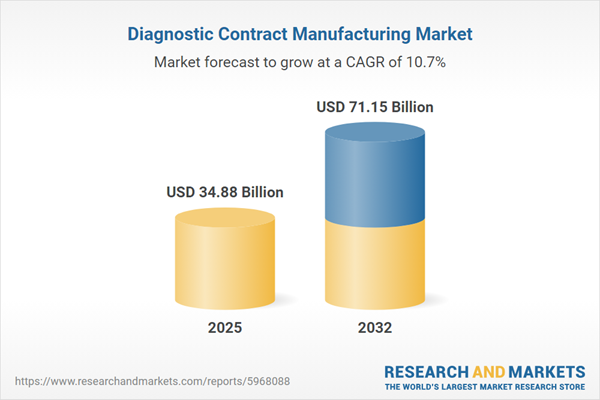Speak directly to the analyst to clarify any post sales queries you may have.
The diagnostic contract manufacturing market is undergoing rapid transformation, shaped by evolving technologies and new regulatory requirements. Senior decision-makers now face a dynamic landscape where flexible, scalable solutions and strategic partnerships are central to competitive success.
Market Snapshot of the Diagnostic Contract Manufacturing Market
The Diagnostic Contract Manufacturing Market grew from USD 31.49 billion in 2024 to USD 34.88 billion in 2025. It is expected to continue growing at a CAGR of 10.72%, reaching USD 71.15 billion by 2032.
This robust market expansion reflects intensifying demand for precise diagnostic assays and reagents, triggered by increasingly complex workflows in life sciences and healthcare sectors. Enhanced digitalization and regulatory shifts continue to foster a global environment where contract outsourcing is not just an operational lever but a strategic necessity for sustained innovation.
Scope & Segmentation of the Diagnostic Contract Manufacturing Market
The report provides a comprehensive analysis across critical market dimensions, equipping leaders to identify tailored opportunities and operational challenges:
- Service Types: Analytical testing, method development, sample preparation, stability testing
- End Users: Academic institutes, biotech companies, pharmaceutical companies, research organizations
- Technologies: Chromatography, immunoassays, mass spectrometry, PCR
- Products: Consumables, instruments, reagents
- Applications: Clinical diagnostics, food and environmental testing, forensic analysis
- Regions: Americas, Europe, Middle East & Africa, Asia-Pacific
- Key Companies: Thermo Fisher Scientific, Lonza, Catalent, Samsung Biologics, Wuxi AppTec, Recipharm, Boehringer Ingelheim, FUJIFILM Diosynth Biotechnologies, AGC Biologics, Ajinomoto Bio-Pharma Services
Key Takeaways for Senior Decision-Makers
- Outsourcing in the diagnostic contract manufacturing market is expanding beyond traditional activities to encompass bioanalysis, chemical and microbial testing, and complex method development.
- Technological grounds are shifting as contract manufacturers integrate digital platforms, automation, and AI-driven quality control to streamline high-throughput workflows and mitigate risk.
- Customization and flexible manufacturing capacity are in higher demand, with both established firms and startups seeking scalable models to fast-track innovation and manage costs prudently.
- Regional factors shape operational strategy; North America and Asia-Pacific are investing in advanced infrastructure, while EMEA markets emphasize regulatory compliance and localized partnership models.
- Partnerships, consolidation of niche players, and sustainability initiatives are pivotal as companies navigate evolving standards and stakeholder expectations across global supply chains.
- Emerging applications in clinical diagnostics, food safety, and forensic science signify the market’s widening impact across diverse sectors.
Tariff Impact: Navigating U.S. Trade Policy Changes
The introduction of new United States tariffs in 2025 directly affects capital and operational costs for contract manufacturers sourcing reagents, consumables, and instrumentation internationally. These changes have prompted many companies to explore nearshoring, diversify suppliers, and invest in modular facility designs to buffer cost fluctuations. Some organizations are reformulating reagents using local raw materials to ensure supply chain resilience. Adapting sourcing and facility strategies is becoming essential for maintaining margin stability and market agility.
Methodology & Data Sources
This research integrates primary interviews with contract manufacturing executives, technology vendors, and regulatory experts. Supplemented by secondary data analysis of regulatory documents, peer-reviewed publications, and market press releases, the methodology triangulates quantitative data and qualitative insights. Final validation is achieved through expert workshops to ensure accuracy and industry relevance.
Why This Report Matters
- Enables strategic investment decisions by mapping current trends in technologies, applications, and regional infrastructure.
- Supports risk management and resilience planning amid fluctuating geopolitical and regulatory climates, especially in response to trade policy changes.
- Guides operational optimization and partnership strategies that align with market-driven imperatives and evolving client needs.
Conclusion
Senior stakeholders can leverage this report to stay ahead of regulatory shifts, technological advances, and structural changes in the diagnostic contract manufacturing market. The insights presented provide a practical foundation to inform resource allocation, strategic partnerships, and market-entry decisions.
Additional Product Information:
- Purchase of this report includes 1 year online access with quarterly updates.
- This report can be updated on request. Please contact our Customer Experience team using the Ask a Question widget on our website.
Table of Contents
3. Executive Summary
4. Market Overview
7. Cumulative Impact of Artificial Intelligence 2025
Companies Mentioned
The companies profiled in this Diagnostic Contract Manufacturing market report include:- Thermo Fisher Scientific, Inc.
- Lonza Group AG
- Catalent, Inc.
- Samsung Biologics Co., Ltd.
- Wuxi AppTec Co., Ltd.
- Recipharm AB
- Boehringer Ingelheim International GmbH
- FUJIFILM Diosynth Biotechnologies, Inc.
- AGC Biologics Co., Ltd.
- Ajinomoto Bio-Pharma Services
Table Information
| Report Attribute | Details |
|---|---|
| No. of Pages | 185 |
| Published | October 2025 |
| Forecast Period | 2025 - 2032 |
| Estimated Market Value ( USD | $ 34.88 Billion |
| Forecasted Market Value ( USD | $ 71.15 Billion |
| Compound Annual Growth Rate | 10.7% |
| Regions Covered | Global |
| No. of Companies Mentioned | 11 |









